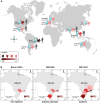Zoonotic Epidemic of Sporotrichosis: Cat to Human Transmission
- PMID: 28103311
- PMCID: PMC5245785
- DOI: 10.1371/journal.ppat.1006077
Zoonotic Epidemic of Sporotrichosis: Cat to Human Transmission
Conflict of interest statement
The authors have declared that no competing interests exist.
Figures

References
-
- Mackay BM, Menrath VH, Ridley MF, Kellym WR. Sporotrichosis in a cat. Aust Vet Practit. 1986. March; 16(1):3–5.
-
- Gonzalez Cabo JF, de las Heras Guillamon M, Latre Cequiel MV, Garcia de Jalon Ciercoles JA. Feline sporotrichosis: a case report. Mycopathologia. 1989. December;108(3):149–154. - PubMed
-
- Hirano M, Watanabe K, Murakami M, Kano R, Yanai T, Yamazoe K, et al. A case of feline sporotrichosis. J Vet Med Sci. 2006. April;68(3):283–284. - PubMed
Publication types
MeSH terms
LinkOut - more resources
Full Text Sources
Other Literature Sources
Medical
Miscellaneous

